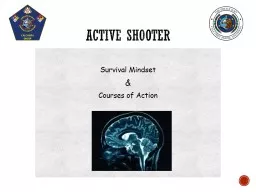PPT-Survival Mindset & Courses of Action
Author : pamella-moone | Published Date : 2018-10-13
ACTIVE SHOOTER 2 Part One run hide fight Run Hide Fight 4 Part Two The Basics About Active Shooters 5 Active Shooter Definition Active Shooter executes a random
Presentation Embed Code
Download Presentation
Download Presentation The PPT/PDF document "Survival Mindset & Courses of Action" is the property of its rightful owner. Permission is granted to download and print the materials on this website for personal, non-commercial use only, and to display it on your personal computer provided you do not modify the materials and that you retain all copyright notices contained in the materials. By downloading content from our website, you accept the terms of this agreement.
Survival Mindset & Courses of Action: Transcript
Download Rules Of Document
"Survival Mindset & Courses of Action"The content belongs to its owner. You may download and print it for personal use, without modification, and keep all copyright notices. By downloading, you agree to these terms.
Related Documents













![[DOWNLOAD] - The Test Prep Mindset Pocketbook: The Essential Guide for Developing the](https://thumbs.docslides.com/906023/download-the-test-prep-mindset-pocketbook-the-essential-guide-for-developing-the-proper-mindset-to-achieve-high-scores-on-your-sta.jpg)
